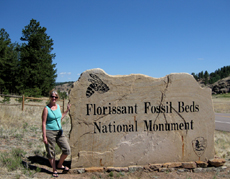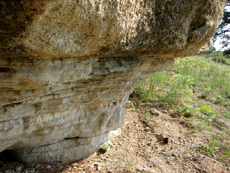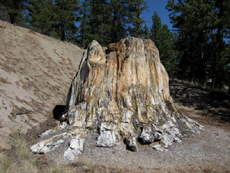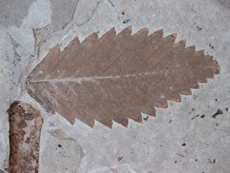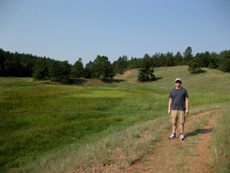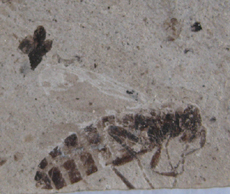
 |
 |
| Click
on the first image and advance through the slides to explore
Florissant Fossil Beds National Monument. Click on Florissant
Fossil Beds National Monument for a printable version of
our article. |
|
Bibliography |
|
| Boyle B., Meyer, H.W., Enquist, B., and Salas S.
(2008). Higher taxa as paleoecological and paleoclimatic indicators:
A search for the modern analog of the Florissant fossil flora.
In Meyer H.W. and Smith, D.M. [Eds.] Paleontology of the
Upper Eocene Florissant Formation, Colorado. (pp. 33-51). The Geological
Society of America, Special Paper 435.
Brosius, L. (1994). In pursuit of Prodryas persephone: Frank Carpenter and fossil insects. Psyche 101: pp. 119-126. doi: 10.1155/1994/89176 Cleal C.J. & Thomas B.A. (2009). Introduction to Plant Fossils. United Kingdom: Cambridge University Press. Evanoff, E., Gregory-Wodzicki K.M. and Johnson, K.R. [Eds.], (2001). Fossil Flora and Stratigraphy of the Florissant Formation, Colorado. Proceedings of the Denver Museum of Nature and Science, series 4, number 1. Evanoff, E., McIntosh, W.C. and Murphey, P.C. (2001). Stratigraphic Summary and 40Ar/39Ar Geocrhonology of the Florissant Formation, Colorado. In Evanoff, E., Gregory-Wodzicki K.M. and Johnson, K.R. [Eds.] Fossil Flora and Stratigraphy of the Florissant Formation, Colorado. (pp. 1-16). Proceedings of the Denver Museum of Nature and Science, series 4, number 1. Foos, A. & Hannibal,
J. (1999). Geology of Florissant Fossil Beds National
Monument. Gregory-Wodzicki, K. M. (2001). Paleoclimatic Implications of Tree-Ring Growth Characteristics of 34.1 Ma Sequoioxylon pearsallii from Florissant, Colorado. In Evanoff, E., Gregory-Wodzicki K.M. and Johnson, K.R. [Eds.] Fossil Flora and Stratigraphy of the Florissant Formation, Colorado. (pp. 163-186). Proceedings of the Denver Museum of Nature and Science, series 4, number 1. Grimaldi, D. & Engel, M.S., (2006). Evolution of the Insects. New York: Cambridge University Press. Henning, J.T., Smith, D.M., Nufio, C.R. and Meyer, H.W. (2012). Depositional setting and fossil insect preservation: a study of the late Eocene Florissant Formation, Colorado. Palaios 27: 481-488. KellerLynn, K. (2006). Florissant Fossil Beds National Monument Geologic Resource Evaluation Report. Natural Resource Report NPS/NRPC/GRD/NRR—2006/009. National Parks Service, Denver, Colorado Leopold, E.B. and Clay-Poole, S.T. (2001). Fossil leaf and pollen floras of Colorado compared: climatic implications. In Evanoff, E., Gregory-Wodzicki K.M. and Johnson, K.R. [Eds.] Fossil Flora and Stratigraphy of the Florissant Formation, Colorado. (pp. 17-55). Proceedings of the Denver Museum of Nature and Science, series 4, number 1. Leopold, E.B. and Meyer, H.W. (2012). Saved in Time: The Fight to Establish Florissant Fossil Beds National Monument. Albuquerque: University of New Mexico Press. Leo Lesquereux Autobiography, American Philosophical Society,
see: Lloyd, K. J., Worley-Georg, M.P., and Eberle J.J. (2008). The Chadronian mammalian fauna of the Florissant Formation, Florissant Fossil Beds National Monument, Colorado. In Meyer H.W. and Smith, D.M. [Eds.] Paleontology of the Upper Eocene Florissant Formation, Colorado. (pp. 117-126). The Geological Society of America, Special Paper 435. Lloyd, K.J., and Eberle, J.J. (2008). A new talpid from the late Eocene of North America. Acta Palaeontologica Polonica 53 (3): 539-543. MacGinitie, H.D. (1953). Fossil Plants of the Florissant Beds, Colorado. Washington, D.C.: Carnegie Institution of Washington Publication 599. Manchester, S.R., (2001). Update on the megafossil flora of Florissant, Colorado. In Evanoff, E., Gregory-Wodzicki K.M. and Johnson, K.R. [Eds.] Fossil Flora and Stratigraphy of the Florissant Formation, Colorado. (pp. 137-161). Proceedings of the Denver Museum of Nature and Science, series 4, number 1. Matthews, V., KellerLynn, K., and Fox, B. (2003). Messages in Stone: Colorado’s Colorful Geology. Canada: Colorado Geologic Survey. McChristal, J. (1994). A
History o Florissant Fossil Beds National Monument: In
Celebration of Preservation. Available
as a pdf on the National Park Service E-Library: Meyer, H.W. (2001). A Review of the paleoelevation estimates for the Florissant flora, Colorado. In Evanoff, E., Gregory-Wodzicki K.M. and Johnson, K.R. [Eds.] Fossil Flora and Stratigraphy of the Florissant Formation, Colorado. (pp. 205-216). Proceedings of the Denver Museum of Nature and Science, series 4, number 1. Meyer, H.W. (2003). The Fossils of Florissant. Washington: Smithsonian Books. Meyer, H.W., Veatch, S.W. and Cook, A. (2004). Field guide to the paleontology and volcanic setting of Florissant fossil beds, Colorado (pp. 151-166). In Nelson, E.P. and Erslev, E.A. [Eds.] Field Trips in the Southern Rocky Mountains, USA. Geological Society of America Field Guide 5. Meyer, H.W. and Smith, D.M., [Eds.], (2008). Paleontology of the Upper Eocene Florissant Formation, Colorado. Geologic Society of America Special Paper 435. Meyer, H.W., Wasson, M.S., and Frakes, B.J. (2008). Development of an integrated paleontological database and Web site of Florissant collections, taxonomy, and publications. In Meyer, H.W., and Smith, D.M., [Eds.], Paleontology of the Upper Eocene Florissant Formation, Colorado (pp. 159-177). Geological Society of America Special Paper 435. Moe, A.P. & Smith, D.M. (2005). Using pre-Quaternary Diptera as indicators of paleoclimate. Palaeogeography, Palaeoclimatology, Palaeoecology 221: 203-214. Mustoe, G.E. (2008). Mineralogy and geochemistry of late Eocene silicified wood from Florissant Fossil Beds National Monument, Colorado. In Meyer, H.W., and Smith, D.M., [Eds.], Paleontology of the Upper Eocene Florissant Formation, Colorado (pp. 127-140). Geological Society of America Special Paper 435. National Park Service website for Florissant Fossil Beds National
Monument, Colorado. Homesteaders and Settlers page: Nudds, J.R. & Selden, P.A. (2008). Fossil Ecosystems of North America: A Guide to the Sites and Their Extraordinary Biotas. Chicago: The University of Chicago Press. O’Brien, N.R., Meyer, H.W., Reilly, K., Ross, A.M., and Maguire, S., (2002). Microbial taphonomic processes in the fossilization of insects and plants in the late Eocene Florissant Formation, Colorado: Rocky Mountain Geology, v. 17, pp. 1-11). Pick, N. and Sloan, M. (2004). The Rarest of the Rare: Stories Behind the Treasures at the Harvard Museum of Natural History. New York: HarperCollins Publishers Inc. Prothero, D.R. and Sanchez, F., (2004). Magnetic stratigraphy of the upper Eocene Florissant Formation, Teller County, Colorado. In Lucas, S.G., Zeigler, K.E., and Kondrashov, P.E. [Eds.]. Paleogene Mammals. (pp. 129-135). New Mexico Museum of Natural History and Science Bulletin 26. Stewart, W.N. and Rothwell, G.W. (1993). Paleobotany and the Evolution of Plants [2nd Ed.]. New York: Cambridge University Press. Veatch S.W. and Meyer, H.W. (2008). History of paleontology at the Florissant fossil beds, Colorado. In Meyer, H.W., and Smith, D.M., [Eds.], Paleontology of the Upper Eocene Florissant Formation, Colorado (pp. 1-18). Geological Society of America Special Paper 435. Wheeler E.A. (2001). Fossil Dicotyledonous Woods from Florissant Fossil Beds National Monument, Colorado. In Evanoff, E., Gregory-Wodzicki K.M. and Johnson, K.R. [Eds.] Fossil Flora and Stratigraphy of the Florissant Formation, Colorado. (pp. 1-16). Proceedings of the Denver Museum of Nature and Science, series 4, number 1. Wheeler E.A. and Meyer, H.W. (2012). A new (Hovenia) and an old (Chadronoxylon) fossil wood from the late Eocene Florissant Formation, Colorado, U.S.A. IAWA Journal, 33(3) –001-010. Wilf, P. 1997. When are leaves good thermometers? A new case for Leaf Margin Analysis. Paleobiology 23: 373-390. Wilf, P., S.L. Wing, D.R. Greenwood and C.L. Greenwood 1998. Using fossil leaves as paleoprecipitation indicators: An Eocene example. Geology 26: 203-206. Wolfe, J.A. 1995. Paleoclimatic estimates from Tertiary leaf
assemblages. Annual Reviews of Earth and Planetary Science 23:119-142. |
|











